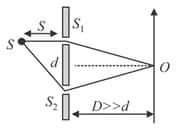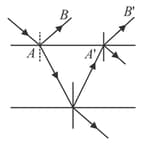To make the central fringe at the centre a mica sheet of refractive index is introduced. Choose the correct statements



Important Questions on Wave Optics
Consider interference between two sources of intensity and . Find out resultant intensity where phase difference is
Express all your answers in the form where is real number up to two decimal places. Find .
Consider interference between two sources of intensity and . Find out resultant intensity where phase difference is
Express all your answers in the form where is real number up to two decimal places. Find .
Consider interference between two sources of intensity and . Find out resultant intensity where phase difference is
Express all your answers in the form where is real number up to two decimal places. Find .
A ray of light of intensity I is incident on a parallel glass-slab at a point as shown in figure. It undergoes partial reflection and refraction. At each reflection of incident energy is refracted. The rays and undergo interference. The ratio of is . Write the value of .

